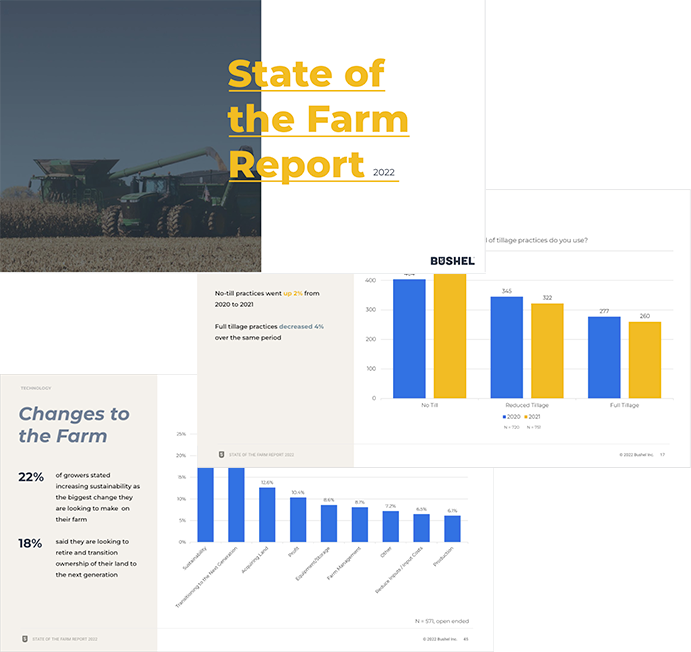Farmers Are Willing To Change
2022 State of the Farm Report
The 2022 State of the Farm Survey collected information from around the country to see how farms of all sizes manage their day-to-day operations. We surveyed nearly 1,000 growers to uncover current trends in farm management. The report analysis found that the vast majority of farmers are willing to make major changes to their production practices, whether it be to make a positive impact on their profitability or the environment.

Farmers Are Willing To Change
The 2022 State of the Farm Report found that, of the 92% of growers who are happy with the way they currently farm, 77% said they would be willing to change the way they farm if it would have a positive impact on the environment. Ninety-six percent of them said they would change if they believed they would become more profitable.
No-till farming increased by 2% from 2020 to 2021 and full tillage decreased by 4% according to the 2022 survey. These numbers coincide with trends found in the latest census report (2017) which stated that from 2012-2017, there was a 24% increase in reduced till acres and an 8% increase in no-till acreage. Acreage of intensive till decreased by 24% and the number of farms that operate with intensive till was reduced by 35%.
The increase in no-till and reduced tillage can be attributed to many factors, but the benefits of less tillage are likely significant contributors to this change. No-till farming can result in reduced erosion, labor, and fuel cost, while increasing soil biodiversity, organic matter, and water retention. Less fuel cost, less topsoil loss, and less labor are the most prominent benefits farmers see from using no-till according to the State of the Farm survey.
We understand that no-till may not be the best solution for every farm due to geographical differences, but we also acknowledge the amount of farms that are changing production practices away from intensive tillage. High cost, lack of knowledge, and the level of difficulty planting are the main roadblocks stopping farmers from using no-till according to the State of the Farm report.
Eighty-two percent of those growers would be willing to change farming practices to participate in a carbon credit program. With the incentives of carbon credit programs and the increase in no-till and reduced tillage practices, profitability and more environmentally practices are working hand-in-hand to benefit not only the land, but also those who farm the land.
It’s becoming easier and easier to enroll in these incentives with the help of ag tech. The convergence of regenerative agriculture and data collection through technology allows for a mutually beneficial relationship that brings more profit to producers. FarmLogs software allows producers to easily integrate the data they already have to enroll in carbon market opportunities with companies such as Nori and Cargill RegenConnect.
The evolution of agricultural technology has made great progress across the entire ag supply chain. The idea of precision agriculture has been around for awhile, but putting that technology into practice has seen exponential growth in recent years. Seventy-one percent of respondents (an increase of 8% since 2020) use FarmLogs, a farm management application. Machinery is constantly being improved to make feeding more people more efficient, but what about the rest of a crop’s journey?

Where agriculture has once lagged, a desire for a more digital experience has been fulfilled. With Bushel’s digital infrastructure, grain facilities are using technology to increase their productivity and create a better experience for their growers. Ninety percent of eSign contracts sent via Bushel Mobile ™ are signed digitally. Thirty-one percent of offers come through a mobile app for Bushel Trade ™ customers that have mobile offer entry enabled. Digital infrastructure has the opportunity to be the connecting point in each step of the grain supply chain, and that starts with the 25% of growers who are ready to sell their crops through an app.
Summary
The 2022 State of the Farm survey results show that growers are willing to change practices for the better. The majority of participants are willing to make major changes to create positive environmental impacts. Reduced and no-till operations are continuing to rise as well as the interest in carbon credit opportunities. Overall, the survey participants were willing to make changes to production practices based on the opportunity for profit. Other changes include people seeing the value in a digital experience at their fingertips and embracing the use of new technology. Growers want to participate in best practices to nurture the land they cultivate.
To view the full 2022 State of the Farm Report click here.